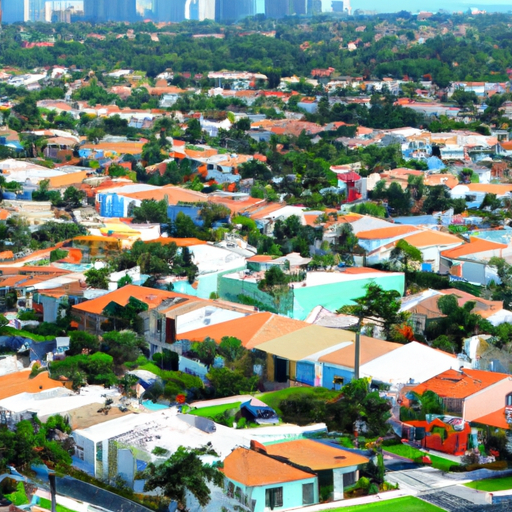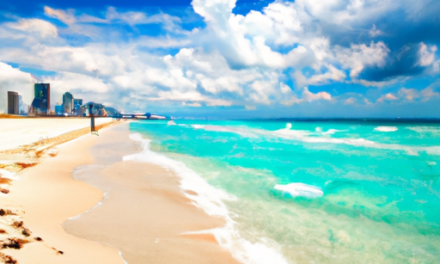In this article, you will learn about the influence of Miami’s climate on its lifestyle. Miami, known for its sunny weather and tropical climate, has a significant impact on how its residents live their lives. From outdoor activities to fashion choices, the climate plays a crucial role in shaping the city’s lifestyle. With an average annual temperature of around 77 degrees Fahrenheit, Miami’s climate lends itself to an outdoor-oriented lifestyle. You will find residents enjoying activities such as swimming, sunbathing, and water sports throughout the year. The warm and sunny weather creates a vibrant and energetic atmosphere that promotes an active lifestyle. Additionally, the tropical climate influences the fashion choices in Miami, with residents often seen wearing light and colorful clothing to adapt to the hot and humid weather. Miami’s climate plays a significant role in shaping its unique and vibrant lifestyle. With its tropical climate, high temperatures, and frequent rainfall, Miami offers a plethora of outdoor activities, influences fashion trends, impacts architecture and design choices, and even affects the culinary scene. In this article, we will explore how Miami’s climate shapes various aspects of its lifestyle and the challenges it faces in the face of climate change.
Climate of Miami
Miami enjoys a tropical climate with high temperatures throughout the year. The average temperature hovers around 75°F (24°C), making it an ideal location for those seeking warm weather year-round. However, it’s important to note that during the summer months, temperatures can soar to the 90s°F (32-34°C), accompanied by high humidity levels.
Tropical climate with high temperatures
Miami’s tropical climate is a major draw for both tourists and locals. The consistent warmth allows for outdoor activities and events to take place year-round, contributing to the vibrant lifestyle of the city. Whether it’s lounging on the beach or exploring the city’s parks and nature reserves, there is always an opportunity to enjoy the outdoors.
Humidity levels and their impact on daily life
Alongside high temperatures, Miami experiences high humidity levels, especially during the summer months. The humidity can make the air feel heavy and damp, which can be uncomfortable for some individuals, particularly those who are not accustomed to such conditions. However, the humidity also plays a role in shaping the city’s atmosphere, with outdoor dining experiences and water sports being heavily influenced by the location’s unique climate.
Frequency and intensity of rainfall
Miami is known for its frequent rainfall, especially during the summer months. The city receives an average of 60 inches of rain each year, often in the form of afternoon showers or thunderstorms. While the rain can be heavy and disruptive at times, it also helps to cool down the city and replenish the many bodies of water in the area, including Biscayne Bay and the Atlantic Ocean.
Outdoor Activities in Miami
Miami’s climate offers excellent opportunities for outdoor activities, which have become an integral part of the city’s lifestyle.
Beach culture and water sports
Miami’s miles of pristine beaches are a major attraction for locals and tourists alike. The warm climate and crystal-clear waters make it ideal for swimming, sunbathing, and a range of water sports such as surfing, paddleboarding, and jet skiing. The beach culture in Miami is deeply ingrained in the lifestyle, with many people spending their weekends enjoying the sun and surf.
Gardening and outdoor events
The pleasant climate in Miami also lends itself well to gardening and outdoor events. The city is home to numerous parks, botanical gardens, and nature reserves where residents can indulge in gardening or simply enjoy a leisurely stroll amidst lush greenery. Additionally, Miami hosts several outdoor events, including concerts, art festivals, and food fairs, allowing people to engage in cultural activities while basking in the pleasant weather.
Exploring parks and nature reserves
Miami’s climate supports the growth of diverse flora and fauna, which can be explored in the numerous parks and nature reserves scattered throughout the city. From the iconic Everglades National Park to the Fairchild Tropical Botanic Garden, there are countless opportunities for nature enthusiasts to immerse themselves in Miami’s unique tropical ecosystem. Whether it’s bird-watching, hiking, or simply enjoying a picnic in nature, Miami’s outdoor spaces offer a respite from the bustling city life.
Fashion and Lifestyle in Miami
Miami’s climate has a profound influence on fashion and lifestyle choices, creating a distinctive style unique to the city.
Casual and light clothing choices
Given the high temperatures and humidity, Miami’s residents embrace casual and lightweight clothing as part of their daily attire. Light fabrics such as cotton and linen are favored, and vibrant colors and floral patterns are often seen adorning dresses, shirts, and shorts. The emphasis is on staying comfortable while still looking fashionable in the warm climate.
Swimwear as a regular attire
With its abundance of beautiful beaches and pools, it’s no surprise that swimwear is a regular attire in Miami. Many residents incorporate swimwear into their everyday outfits, whether it’s a bikini top paired with shorts or a swim cover-up worn as a dress. The tropical climate allows people to make the most of their swimwear collection and enjoy a laid-back lifestyle.
Influence on fashion trends
Miami’s climate has a significant influence on fashion trends, not only within the city but also globally. The vibrant colors, floral prints, and beach-inspired attire often seen in Miami have made their way into the international fashion scene. Designers and fashion enthusiasts draw inspiration from the city’s warm climate, incorporating elements of Miami style into their collections. Miami has become synonymous with a vibrant, tropical aesthetic that is beloved by many.
Architecture and Design Adaptations
Miami’s climate necessitates specific adaptations in architecture and design to accommodate the city’s unique weather conditions.
Building materials and construction techniques
In Miami, buildings are constructed using materials and techniques that can withstand the high temperatures and heavy rainfall. Durable materials such as concrete and impact-resistant glass are commonly used to ensure the structures can withstand the intense weather conditions, including hurricanes. Additionally, many buildings incorporate design elements like overhangs and shading systems to provide relief from the sun’s heat.
Designing for natural ventilation
With high humidity levels and warm temperatures, designing buildings for natural ventilation is essential. Architects in Miami often incorporate features such as large windows, courtyards, and open layouts to maximize the circulation of air, reducing the need for excessive air conditioning. By embracing natural ventilation, buildings can create a comfortable and energy-efficient environment for occupants.
Impact on interior design choices
Miami’s climate also influences interior design choices, with a focus on creating spaces that feel cool and refreshing. Light colors, natural materials, and breezy textures are commonly used to evoke a relaxed and airy atmosphere. Additionally, indoor-outdoor living spaces, such as balconies and terraces, are popular, further blurring the lines between the indoors and outdoors.
Miami’s Culinary Scene
Miami’s climate has a direct impact on its vibrant culinary scene, showcasing fresh ingredients and flavors influenced by the city’s multicultural makeup.
Emphasis on fresh and vibrant ingredients
Miami’s warm climate allows for the growth of a variety of fresh produce, resulting in a culinary scene that emphasizes vibrant, flavorful ingredients. Local farmers’ markets offer an abundance of fruits, vegetables, and herbs, allowing chefs and home cooks alike to create dishes bursting with freshness. From tropical fruits like mangoes and guavas to fragrant herbs like cilantro and mint, Miami’s cuisine is a fusion of flavors that reflect its diverse cultural heritage.
Influence of Latin American flavors
Miami’s multicultural population, particularly its strong Latin American influence, has shaped the city’s culinary landscape. The vibrant flavors of Cuban, Peruvian, Colombian, and other Latin American cuisines are prevalent in Miami’s menus. From savory dishes like Cuban sandwiches and ceviche to sweet treats like flan and churros, Miami’s food scene offers a delightful array of Latin American flavors that transport diners to a different part of the world.
Outdoor dining experiences
Given Miami’s pleasant climate, outdoor dining experiences are popular throughout the city. Many restaurants offer patio seating, allowing diners to enjoy their meals al fresco while soaking up the warm weather. From waterfront establishments to sidewalk cafes, outdoor dining has become a staple of Miami’s culinary scene, creating a unique and enjoyable experience for locals and visitors alike.
Health and Wellbeing
Miami’s climate has both positive and negative impacts on health and wellbeing, necessitating certain precautions to maintain a balanced lifestyle.
Importance of hydration
With high temperatures and humidity levels, staying hydrated is crucial in Miami. Whether engaging in outdoor activities or simply going about one’s daily routine, it is important to drink plenty of water to prevent dehydration. It is recommended to carry a water bottle at all times and take regular water breaks, especially during the hottest parts of the day.
Precautions against excessive sun exposure
Due to its climate, Miami experiences abundant sunshine throughout the year. While sun exposure is beneficial in moderate amounts, it is crucial to take precautions to protect the skin from harmful UV rays. Wearing sunscreen with a high SPF, seeking shade during the hottest hours of the day, and wearing wide-brimmed hats and sunglasses are important steps to safeguard against sunburn and other sun-related skin damage.
Effects on mental health and stress levels
Miami’s warm climate and access to outdoor spaces have a positive impact on mental health and stress levels. Spending time in nature, whether it’s walking along the beach or exploring a park, can promote relaxation and a sense of well-being. The constant availability of outdoor activities gives residents ample opportunities to engage in physical exercise, which is known to have positive effects on mental health.
However, it’s important to note that the extreme heat and humidity can also have adverse effects on certain individuals, leading to feelings of fatigue, irritability, and discomfort. It is essential to listen to your body and take necessary breaks to avoid overexertion.
Transportation and Infrastructure
Miami’s climate has prompted various adaptations in transportation and infrastructure to cope with the unique weather conditions.
Impact on public transportation systems
Miami’s high temperatures and humidity levels have an impact on the efficiency and comfort of public transportation systems. Air-conditioned buses and trains provide relief from the heat, ensuring a more pleasant commute for residents and tourists. Additionally, public transportation plays a vital role in reducing road congestion and carbon emissions, contributing to a more sustainable and environmentally friendly city.
Focus on bike and pedestrian-friendly paths
Miami’s pleasant climate encourages alternative modes of transportation such as biking and walking. The city has made significant investments in creating bike lanes, pedestrian-friendly paths, and shared mobility initiatives. These efforts not only promote a healthier and more active lifestyle but also reduce the dependence on cars, leading to a more sustainable and less congested urban environment.
Adapting infrastructure for climate changes
Miami is acutely aware of the challenges posed by climate change, including rising sea levels and increased frequency of extreme weather events. As a result, the city is actively working on adapting its infrastructure to withstand and mitigate these challenges. Initiatives include raising roads, constructing seawalls, and implementing flood prevention measures. These adaptations are crucial not only for safeguarding the city’s physical infrastructure but also for ensuring the safety and wellbeing of its residents.
Tourism and Economy
Miami’s climate plays a pivotal role in its status as a major tourist destination and influences its economic growth.
Tourism as a major industry
Tourism is one of Miami’s major industries, attracting millions of visitors each year. The warm climate and abundance of outdoor activities make it an attractive destination for those seeking sun, sand, and sea. Tourists flock to Miami’s beaches, explore its vibrant neighborhoods, and indulge in its multicultural cuisine, contributing significantly to the local economy.
Effects of climate on tourist activities
Miami’s leisure activities are heavily influenced by its climate. Tourists can enjoy a wide range of water sports, lounge on the beach, or explore the city’s parks and nature reserves. The climate also enables year-round outdoor events and festivals that showcase Miami’s rich cultural heritage. However, extreme weather events such as hurricanes can disrupt tourist activities, leading to temporary closures and relocation of events.
Economic impact of extreme weather events
Miami is highly susceptible to the impacts of climate change, with rising sea levels and increased frequency of extreme weather events. These events, such as hurricanes and flooding, can have severe economic consequences. Damage to infrastructure, disruptions to businesses, and potential decline in tourist numbers all contribute to economic challenges for the city. Miami faces the daunting task of strengthening its resilience and adaptability to mitigate the potential economic impact of these events.

Climate Change and Miami’s Future
Miami’s future is intricately linked to the challenges posed by climate change and the need for sustainability and resilience.
Rising sea levels and coastal erosion
As a coastal city, Miami faces a significant threat from rising sea levels and coastal erosion. The low-lying nature of the region makes it particularly vulnerable to the impacts of climate change. Efforts are underway to address these challenges, including the construction of seawalls and elevation of infrastructure. However, long-term solutions and a collective commitment to reducing greenhouse gas emissions are necessary to protect the city’s future.
Efforts for sustainability and resilience
Miami recognizes the importance of sustainability and resilience in the face of climate change. The city has implemented initiatives to increase renewable energy usage, promote energy efficiency, and reduce carbon emissions. Additionally, steps are being taken to ensure the city’s infrastructure can withstand the impacts of extreme weather events and adapt to future climate changes. These efforts are crucial in safeguarding Miami’s future and creating a sustainable, livable city.
Challenges in adapting to climate change
While Miami has taken significant steps to combat the challenges of climate change, it still faces various obstacles. The costs associated with implementing long-term adaptation strategies, the need for public support and awareness, and the complex nature of regional and global climate governance are among the challenges that must be overcome. Collaboration between government, businesses, and residents is essential to create a resilient and sustainable Miami for future generations.
Conclusion
Miami’s climate has a profound impact on its lifestyle, shaping everything from outdoor activities and fashion trends to architecture and culinary experiences. The tropical climate, high temperatures, and frequent rainfall create a unique atmosphere that locals and tourists alike embrace. However, Miami also faces significant challenges in the face of climate change, requiring innovative solutions and a commitment to sustainability and resilience. By recognizing and addressing these challenges, Miami can continue to thrive and maintain its vibrant lifestyle in the years to come.









